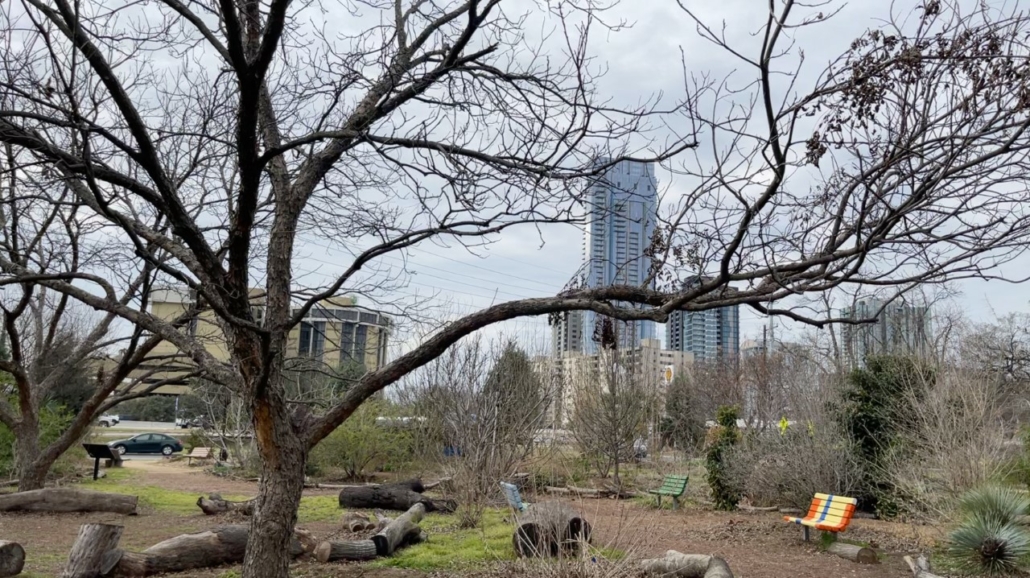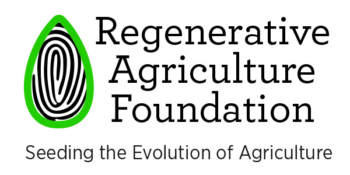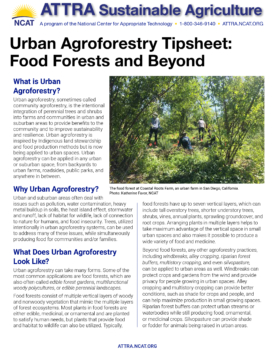Urban Agroforestry Tipsheet: Food Forests and Beyond

The food forest at Coastal Roots Farm, an urban farm in San Diego, California. Photo: Katherine Favor, NCAT
By Katherine Favor, NCAT Agriculture Specialist
What is Urban Agroforestry?
Urban agroforestry, sometimes called community agroforestry, is the intentional integration of perennial trees and shrubs into farms and communities in urban and suburban areas to provide benefits to the community and to improve sustainability and resilience. Urban agroforestry is inspired by Indigenous land stewardship and food production methods but is now being applied to urban spaces. Urban agroforestry can be applied in any urban or suburban space, from backyards to urban farms, roadsides, public parks, and anywhere in between.
Why Urban Agroforestry?
Urban and suburban areas often deal with issues such as pollution, water contamination, heavy metal buildup in soils, the heat island effect, stormwater and runoff, lack of habitat for wildlife, lack of connection to nature for humans, and food insecurity. Trees, utilized intentionally in urban agroforestry systems, can be used to address many of these issues, while simultaneously producing food for communities and/or families.
What Does Urban Agroforestry Look Like?
Urban agroforestry can take many forms. Some of the most common applications are food forests, which are also often called edible forest gardens, multifunctional woody polycultures, or edible perennial landscapes.
Food forests consist of multiple vertical layers of woody and nonwoody vegetation that mimic the multiple layers of forest ecosystems. Most plants in food forests are either edible, medicinal, or ornamental and are planted to satisfy human needs, but plants that provide food and habitat to wildlife can also be utilized. Typically, food forests have up to seven vertical layers, which can include tall overstory trees, shorter understory trees, shrubs, vines, annual plants, sprawling groundcover, and root crops. Arranging plants in multiple layers helps to take maximum advantage of the vertical space in small urban spaces and also makes it possible to produce a wide variety of food and medicine.
Beyond food forests, any other agroforestry practices, including windbreaks, alley cropping, riparian forest buffers, multistory cropping, and even silvopasture, can be applied to urban areas as well. Windbreaks can protect crops and gardens from the wind and provide privacy for people growing in urban spaces. Alley cropping and multistory cropping can provide better conditions, such as shade for crops and people, and can help maximize production in small growing spaces. Riparian forest buffers can protect urban streams or waterbodies while still producing food, ornamental, or medicinal crops. Silvopasture can provide shade or fodder for animals being raised in urban areas.
Planning and Establishment
Urban environments have a different set of challenges than rural areas, so before establishing an urban agroforestry project, it’s important to think about these topics:
- Zoning, permitting, and regulation
- Locating underground and above-ground utilities before you dig or plant
- Accessing utilities like water, electricity, and sewage
- Soil testing for heavy-metal toxicity and other contaminants
- Developing a site-remediation plan to deal with contamination and debris
- Making sure you have the appropriate insurance, especially if your urban agroforestry operation is on or near public land
- Developing a plan for maintaining the project in perpetuity
Ecological Design

The Festival Beach Food Forest in Austin, Texas – a food forest on public park land. Photo: Katherine Favor, NCAT
There are thousands of combinations of plants that can be used in urban agroforestry systems, but no matter what plants you choose, make sure that they are well-suited to the planting site. When choosing plants, it is important to consider USDA Plant Hardiness Zone, the size of the growing space, soil type, and how plants in different vertical layers will interact with one another. When possible, choose plants that are native or naturalized, plants with appropriate sizes for the growing space, plants that do not interfere with buildings or overhead wires, plants that are adapted to urban soils,
and plants that are compatible with one another. Also, consider whether plants are toxic to the humans or wildlife that will be using the site.
Another design consideration is irrigation. Because urban agroforestry systems are often densely planted, leaf mold can be a common issue. To avoid leaf mold, choose an irrigation system that doesn’t get leaves wet, such as drip irrigation. Some urban agroforestry systems utilize earthworks for rain and water catchment, but they require
expert installation and are not appropriate for all settings.
Layout and spacing are other important design considerations, in order to avoid competition between plants while satisfying your goals and maximizing production. If you are planting a food forest with multiple vertical layers of plants, be sure to space
overstory trees, understory trees, and shrubs at sufficient distances from one another, in order to avoid niche overlap. Understory plants such as vines, annual plants, and root crops can occupy space under tree canopies, but they should be planted several feet away from tree trunks in order to avoid competition with tree roots. Sprawling groundcover plants with shallow roots may be planted close to other plants without causing excessive competition. If you are implementing another type of agroforestry practice in an urban space, be sure to follow design guidelines for those specific practices, while also taking into account the specific growing conditions of your site and the surrounding urban environment.
Maintenance
- Urban agroforestry systems are inherently complex and require a great deal of management and maintenance in order to thrive. For systems like food forests, their dense and diverse structure requires that most maintenance be done by hand, so having a well-trained labor force is important.
- Urban areas often deal with tough weeds like grasses because of the prevalence of surrounding lawns. Dealing with grass can be challenging, but methods like solarization and biosolarization (killing weeds with sunlight and heat), occultation (blocking sunlight), mulching, sheet mulching, and tillage can help keep grasses at bay.
- In densely planted systems like food forests, competition between species can be an issue. Make sure to plant trees at the recommended spacing for each species, and make sure to maintain a consistent pruning schedule so that the understory plants have access to light. Pruning lower branches ca increase the amount of sunlight that can reach the ground during the early morning and evening, when the sun is low. Branches can also be pruned back so they do not extend over other crops more than is desirable.
- Keep in mind that you will share the space with urban wildlife. Preventative measures like deer fencing, gopher baskets, and Teflon tape are the best ways to deal with wildlife without making the space unsafe for humans.
- In the case of public food forests, municipalities can often offer some maintenance resources to help manage food forests, such as overstory pruning, mowing, irrigation installation, mulching, or something else. Before establishing a food
forest in a public space, work with your local municipality to determine a maintenance plan that works for everyone.

An urban pastured poultry silvopasture system at Coastal Roots Farm in San Diego, California.
Photo: Katherine Favor, NCAT
Social Considerations
Urban agroforestry systems can be great spaces for engaging and educating the community, if that is one of your goals. Some ideas for engaging the community include hosting volunteer days, workshops, festivals, and other events, as well as inviting schools to use the space as an outdoor classroom. Other options include installing educational signage, opening the space for free foraging, offering benches so that people can use the space to connect with nature, and more.
There are lots of different ways that agroforestry can be applied to urban settings to satisfy multiple goals, and urban
agroforestry can take many forms. With creativity, proper planning, a strong ecological design, and a good maintenance plan, urban agroforestry can help produce food in urban areas while providing many other ecosystem services to the community.
Urban Agroforestry Tipsheet: Food Forests and Beyond
By Katherine Favor, NCAT Agriculture Specialist
Published January 2023
©NCAT
IP630
Slot 668
Version 010623
This publication is produced by the National Center for Appropriate
Technology through the ATTRA Sustainable Agriculture program, under
a cooperative agreement with USDA Rural Development. This publication
was also made possible in part by funding from the Regenerative Agriculture
Foundation and a grant from the U.S. Department of Agriculture (USDA),
Forest Service, National Agroforestry Center, under the authority of the
Cooperative Forestry Assistance Act of 1978. USDA is an equal opportunity
provider, employer, and lender. ATTRA.NCAT.ORG



